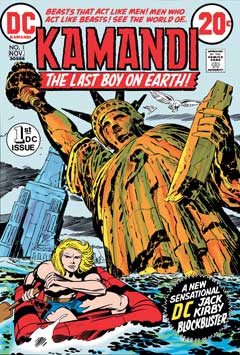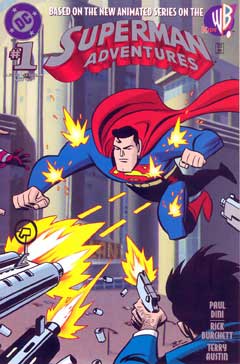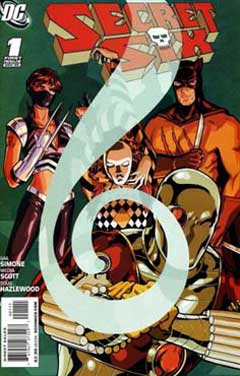- Comics
- Comics Reviews
- Manga
- Comics Reviews
- European Comics
- News
- Comics News
- Press Releases
- Columns
- Spotlight
- Digital Comics
- Webcomics
- Cult Favorite
- Back Issues
- Webcomics
- Movies
- Toys
- Store
- More
- About
By Philip Schweier
August 17, 2013 - 19:51
One of the stories that came out of last month’s
Comic-Con has been getting a lot of air-play in the Inter-webs. It was related
by Paul Pope and first published by Robot 6 at, shall we say, “another Web
site.”

Paul Pope
Pope had enjoyed some healthy success working on Batman, which led to a
conversation with someone whom Pope identifies only as “the head of DC Comics.”
Pope made a pitch to do Kamandi, a character created by comic book legend Jack
Kirby. Touted as “the last boy on Earth,” Kamandi inhabits a post-apocalyptic
world in which animals have risen to become the dominant species. The series
debuted in 1972, at the height of the popularity of the Planet of the Apes
films.
Kamandi ran for 59 issues before it was cancelled in 1978. Since then
the character has made cameo appearances and guest-starred in various titles,
and has been collected into various trade paperback forms.
So Pope made his pitch, the idea being it would be an all-ages
book, only to be stopped midway through.

“We don't publish comics for kids,” the unnamed head of DC is reported to have
said. “We publish comics for 45-year olds. If you want to do comics for kids,
you can do Scooby-Doo.”
Let’s do some math, shall we? The mid-point of Kamandi’s run was #30,
published in early 1975. assuming the average comic reader was 10-years-old at
the time, that would make him now 48.
So basically this unnamed head of DC was saying, “Our target audience is people
who were reading Kamandi back in the mid-’70s as kids.” In my opinion,
he couldn’t be more wrong. I was one of those kids, and there are no DC titles
that interest me.
Based on that statement, it is easy to extrapolate that in 20 years, DC Comics
will be publishing comics for 65-year-olds. It’s a wonderful idea to be able to
maintain a customer throughout their entire life, but what happens when those
customers die off? Where will new readers come from? The answer is obvious: by
appealing to readers of all ages.
Before I continue, I have an beef with the term “all ages,” because
it usually mis-used. It often applies to some G-rated title aimed squarely at
the 10-and-under audience. Consequently, it has no appeal to older comic book
readers, thereby failing to reach all ages.

There was a time when comic book were truly all ages, read and enjoyed
by 10-year-olds, 15-year-olds, 20-year-olds and older. But in the past 20
years or so, comic book companies have begun to throw up walls around their
product, leading to ageism on the part of the publishers. Product aimed at one
segment of comic book readers ignores others.
An example of a truly all-ages title would be Superman Adventures, based
on the Superman animated series of the 1990s. The stories were simple, usually
done-in-one, and followed a streamlined continuity yet to be bogged down by the
rest of the DC Universe. Art was simple, perhaps cartoony, but the stories I
remember all had the same level of sophistication I remember from the Superman
titles of the 1970s.
My point is, it can be done. It is possible to reach all ages in a single
title.
I can imagine a time in comics when comic book creators were perhaps handed the
keys to the kingdom. “We like you,” the publisher said. “We think we can do
great things for each other. So take your pick of our properties, come up with
an idea, and maybe we can do business.”
And creators took them up on it, leading to one-shots and limited
series. Characters long dormant – Blackhawk, Sgt. Rock, the Freedom Fighters,
The Secret Six, the Challengers of the Unknown, Animal Man, and so many others
– enjoyed a brief resurrection. Some were more succesful than others, and
perhaps most eventually faded back into the DC Comics archives.

But makes sense to me that when a publisher has a concept languishing in
obscurity, and a talented writer or artist makes a pitch designed to A.) breath
new life into the character; and B.) reach out to new audiences as well as old,
it makes sense not to discourage the creative process.
Artist Brian Stelfreeze collaborated with writer Joe Pruett on a four-issue Domino
series for Marvel in the 2002. To paraphrase his reasoning, the belief was that
Domino was no so high-profile a character that the risk was so great. At best,
the series might push Domino up the strata of bankable properties. If not, and
the series was a failure, well, who was to notice? It was the more popular
characters who have much more to lose in such situations.
Would that more publishers take that same gamble with their lesser known
properties. Marvel facelifted X-Men in the mid-1970s, and parlayed Blade
into a three-film franchise with a TV series to boot. Gambling on a four or
six-issue miniseries seems less expensive than a film or TV production, so why
not let a creator with a proven track record and lot of enthusiasm take a stab
at a property that has stagnated.
It can’t do worse than the New 52 version of Blackhawks.
Praise and adulation? Scorn and ridicule? E-mail me at
philip@comicbookbin.com